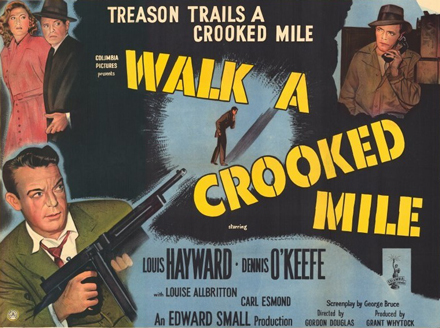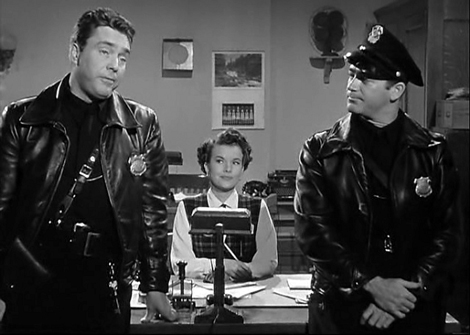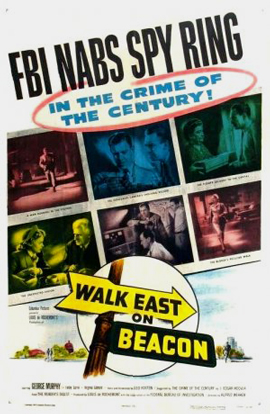|
Starring:
SDtN: Steven Geray, Micheline Cheirel, Eugen Borden;
JOC: Dick Powell, Evelyn Keyes, Lee J. Cobb, Ellen Drew, Nina Foch, Thomas Gomez;
WCM: Louis Hayward, Dennis O'Keefe, Louise Albritton, Carl Esmond, Raymond Burr;
BMaD: Mark Stevens, Edmond O'Brien, Gale Storm, Donald Buka;
WEoB: George Murphy, Finlay Currie, Virginia Gilmore, Karel Stepanek.
Directed by: SDtN: Joseph H. Lewis; JOC: Robert Rossen;
WaCM & BMaD: Gordon Douglas; WEoB: Alfred L. Werker
Reviewed by Glenn Erickson
For its fourth film noir volume, the TCM Vault Collection has licensed five more titles from the Columbia back catalog. It's an interesting batch: an artsy mystery from Joseph H. Lewis, an excellent romantic thriller from Robert Rossen, one police procedural melodrama and two anti-Commie spy hunt pictures. As is typical with Sony product, the transfers and restorations are nearly flawless. Columbia's Torch Lady logo stands like an optimistic beacon to greet five more tales of murder, revenge and traitorous skullduggery. Columbia Pictures Film Noir Classics IV may all but exhaust the studio's holdings on titles remotely suggesting the noir style.

The aptly titled So Dark The Night is an atypical, ambitious picture from the creative Joseph H. Lewis, who had already scored big with Columbia's sleeper success My Name is Julia Ross. Its leading player is actor Steven Geray, a very non-leading man type perhaps being rewarded for his fine supporting turn in Charles Vidor's Gilda. It's Geray's only starring role but he's excellent as a master detective.
Reteaming with cameraman Burnett Guffey, Lewis makes a minor masterpiece from a script by the mostly underachieving writers Martin Berkeley and Aubrey Wisberg. Inspector Henri Cassin (Geray) is an eccentric but brilliant sleuth sent to a French countryside inn for a fortnight's rest. There he meets young Nanette Michaud (Micheline Cheirel), a small town girl engaged to local farmer Leon (Paul Marion). Nanette's advances overcome Henri's misgivings about taking a much younger wife, and he allows himself to be swept up by romance. But when their plans are interrupted by a series of murders Henri vows to catch the killer. Despite his inspired sleuthing, he soon runs out of leads.
So Dark The Night sees Joseph H. Lewis directing at his peak powers, making the most of a not extravagant budget: a patch of the San Fernando Valley becomes a credible substitute for rural France. Lewis's camera is always on the move. He introduces characters with fast details, like feet on a sidewalk, and fingers on clothesline. "Wagon Wheel Joe's" predilection for foreground objects is in full force in shots composed with dramatic depth indicators. Lewis does a fine job of distributing suspicion between several cast members. Is the killer the unhappy maid? (Helen Freeman) The angry father? (Eugene Borden) The hunchback? (Brother Theodore)
Concentrating on Steven Geray's marvelous performance, Lewis contrasts the detective's gentle decency with his dogged determination to identify the murderer, complete with Sherlock Holmes- style clues and theories. Meanwhile, the director adds expressionist touches -- deeper camera angles, strange pauses -- to indicate something unsuspected is amiss. A surprise revelation is accompanied by a radical lighting effect cued by emotion alone. The film presents visual hints of "memory sensations", but no tiresome formal flashback to explain the mystery. A doctor's final speech reminds us of the finish of Alfred Hitchcock's Psycho. A definite film noir for its dark mood and stress on psychological chaos, So Dark The Night is a bold departure from the Hollywood norm.

A front-rank noir, 1947's Johnny O'Clock is the first directing job by the talented Robert Rossen, who would proceed to the classic Body and Soul and earn the Best Picture Oscar for 1949, All the King's Men. The title character is none other than Dick Powell, who here tempers the tough-guy hardboiled talk as he negotiates a path through various intrigues, including murder. The movie also features a trio of notable noir beauties, each in fine form.
Womanizing Johnny O'Clock (Dick Powell) lives a risky life. His partnership with Pete Marchettis (Thomas Gomez) in a swank nightclub is at risk from a crooked, ambitious rival. Worse, Pete's wife Nelle (Ellen Drew) still has a yen for Johnny, and recklessly displays her affections. One murder leads to the apparent suicide of Harriet Hobson (Nina Foch), the club's hatcheck girl. When Harriet's sister Nancy (Evelyn Keyes) arrives, Johnny finds himself seriously falling for her. Meanwhile, Detective inspector Koch (Lee J. Cobb) is sizing up Johnny as a main suspect in the deaths, and Pete Marchettis finds evidence that Nelle and Johnny are a secret item. No matter how Johnny looks at it, he's in a solid frame. His only choice is to try and get Nancy free of the trouble.
Suave and unflappable, Dick Powell's Johnny does daily business with crooks and knows better than to be totally honest with anyone. Catching one of his croupiers stealing money, Johnny lets him stay on with the reasoning that the next man hired might be smarter with his thievery. Johnny's personal assistant Charlie (John Kellogg) is an ex-con who otherwise wouldn't have a job; we can't tell if Johnny has a soft heart or likes having somebody around who is willing to break the law for him. Johnny makes a strong contrast with his partner Marchettis, an unschooled brute frustrated that he can't hold on to Nelle, his trophy wife. Given his poor standing with the police, Johnny is surprised that the intelligent and caring Nancy should choose to stick with him. Women are O'Clock's stumbling block, but also his salvation. The film builds to a suspenseful finish.
Johnny O'Clock benefits from fine low-key B&W cinematography by Burnett Guffey, a true noir stylist. Guffey and director Rossen manage a moody tone even in bright cafes and swank sitting rooms. Evelyn Keyes never looked lovelier and Ellen Drew is irresistibly seductive. Nina Foch's role is much smaller, yet she makes a sympathetic impression. In his second film appearance, actor Jeff Chandler has a nice bit as a gambler from out of town.

Columbia must have liked the title Walk A Crooked Mile as they later released a noir entitled Drive a Crooked Road. But it plays like a re-run of Fox's wartime classic The House on 92nd Street, in which FBI agents infiltrate a Nazi spy ring and discover that they are smuggling top scientific secrets. Now Russian spies are stealing newer formulas out of the high-security Lakeview Laboratory by hiding them in oil paintings. F.B.I agent Dan O'Hara (Dennis O'Keefe) and Scotland Yard 'exchange agent' Scotty Grayson (Louis Hayward) infiltrate the spy network. They barely escape from the murderous Krebs (Raymond Burr), before sorting the innocent from the guilty back at the lab.
Walk A Crooked Mile affects a semi-documentary style that's constantly hopping from city to city and from surveillance stakeouts to places as mundane as a laundry service. Director Gordon Douglas gets good footage on the streets of San Francisco. He also stages an exciting FBI shoot-out of the kind that never happened in real Cold War confrontations. The scene reminds us of John Dillinger's mob caught in the fishing lodge in the 1935 Cagney movie G-Men.
The frequently repeated message is that only dedicated F.B.I. agents can save us from the communist conspiracy menacing us from all sides. One loyal immigrant woman sacrifices her life to protect our heroes, as she'd do anything to help America crush the evil she witnessed back in Eastern Europe. The movie also suspects all scientists to be potential enemies. One is an outright traitor and another (Carl Esmond) is blackmailed into espionage work. Curiously, the movie judges a woman who did the physical smuggling (Louise Allbritton) innocent because her motive was love. Walk A Crooked Mile's impersonal semi-docu style, with narration constantly explaining everything, prevents us from getting too involved in the characters.

The poetically named Between Midnight And Dawn is really just a straightforward police story. The original title Prowl Car better describes a pro-police storyline that sees two cops on the graveyard shift take on a dangerous underworld figure. Director Gordon Douglas delivers a handsomely assembled thriller, filmed on permanently wet nighttime streets. But the script's idea of a compelling conflict is to make one cop a softie and the other a cynic about criminals and women.
Policemen Dan Purvis (Edmond O'Brien) and Rocky Barnes (Mark Stevens) go after the slimy racketeer Ritchie Garris (Donald Buka) while romancing Kate Mallory (Gale Storm), the dispatcher whose voice they hear on their squad car radio. Kate's cop father was killed on the job so she avoids romantic attachments with boys in blue. But her mother purposely rents an apartment to the eager Romeos. Intuiting that a gang war is beginning, Dan and Rocky are able to arrest Garris and make the charge stick. But one jailbreak later, the gangster takes bloody retribution, and threatens innocent citizens. Only Danny is in a position to stop him.
The exciting story plays as if it were written in 1935. The police force is predominantly Irish in makeup. The cops marry cops' daughters and an independent girl who wants to break the pattern is humored and harassed until she gives in. The sexism is complete when the meddling mother refuses to let Kate make her own choices. Dan is secretly angry when Kate chooses the handsome Rocky, but tries to be magnanimous.
The attitude toward organized crime is equally dated. Two lowly patrolmen on the night shift are the spearheads of a major anti- organized crime bust, without really reporting to anyone. What's more, they parade their favorite girl in front of the gangsters, oblivious to the obvious notion that the criminal might strike back at them through her. Interestingly, the woman most threatened is Garris's own girlfriend Terry Romaine (Gale Robbins).
A fresh pace, lively acting (Edmond O'Brien could get any film up on its feet) and sharply directed action make Walk A Crooked Mile an exciting show, even if little or no noir content is evident. The only real concession to postwar thriller conventions is an uptick in violence. The final confrontation sees the rotten Ritchie Garris dangle a young girl from a high window, and threaten to drop her unless the cops back off.

Walk East On Beacon! is a second anti-communist spy drama, released near the end of the cycle in 1952. None of Hollywood's twenty or so contributions to Cold War propaganda were big successes. This one was sourced from an article by J. Edgar Hoover himself, and shapes up as a semi-documentary account of yet another spy ring using an overly complicated system to steal atomic secrets. The noted atom spies Ethel and Julius Rosenberg found it so easy to smuggle secret formulas that the aggressive government prosecution of their case can be attributed to a need to cover up gross deficiencies in the F.B.I.'s security policies. Hoover's account of a different case makes it look as if the F.B.I. has battalions of crack agents in reserve, ready to watch and track hundreds of suspects on a 24-hour basis. The story also stresses the importance of informing on one's friends and relatives in the name of National Security.
F.B.I. operative James Belden (George Murphy) handles a major spy investigation mostly by telephone. An anonymous tip soon leads agents to a Soviet spy ring headed by the ruthless mastermind Alex Laschenkov (Karel Stepanek). He secretly directs dozens of deep-cover agents, two of whom steal information that leads the gang to math genius Dr. Albert Kafer (Finlay Currie) of a secret government scientific think tank. To motivate the old man into coughing up secrets relating to a special project called Falcon, the villains kidnap his son Samuel in Berlin. The loyal Kafer instead informs the F.B.I., putting in motion a slow process to identify and capture all of Laschenko's many embedded spies.
Columbia's film hews closely to the semi-documentary form but director Alfred Werker isn't as adept as was Gordon Douglas at instilling ordinary street scenes with drama and tension. With its many locations and dozens of characters (some with double identities), the film's twisting plot must have left many audiences behind. Characters disappear after being seen just once or twice, but their names keep popping up later. One of two deep-cover husband and wife teams runs a florist shop, and an undertaker is also useful because he has a small printing press. There are just too many characters to keep straight.
British actor Finlay Currie's brave old professor becomes an unlikely double agent for our side. He takes a personal risk to negotiate with Vincent Foss (Jack Manning), a thuggish taxi driver working as a courier-spy. Foss turns out to be an anguished fellow coerced into spying "because of his foolish earlier associations with student radicalism". His own wife informs on him, a frequent occurrence in J. Edgar's version of events. Hoover's 'true' story also manages to finish with a standard action scene as the Navy helps nail the atom spies on the high seas.
Obscure trivia hounds take note: future director George Roy Hill (Butch Cassidy and the Sundance Kid) and his wife Louisa Horton play husband & wife traitors in a just a couple of brief scenes. They only get a few seconds of screen time together. Director Alfred Werker is credited on the superb docu-noir He Walked by Night. He actually left that film early to work on a film for producer Louis de Rochemont, who produced Walk East On Beacon! as well.
The title, by the way, is part of Dr. Kafer's instructions when he's sent on foot to turn over documents to the Soviet blackmailers.
The TCM Vault Collection's Columbia Pictures Film Noir Classics IV DVD set gives each title a separate disc. As with most all Sony transfers, the films are immaculate and have beefy, clear audio. The only drawback is that TCM discs normally do not carry subtitles for the deaf or hearing impaired. The viewing public for these 60 year-old movies skews a little older than that for contemporary films, and many older folk need the subs.
TCM's good extras include galleries of film stills and posters and occasional text essays. Martin Scorsese offers a relaxed video introduction for the collection, while Eddie Muller's essay dodges definitions of film noir by encouraging an all-inclusive debate on the subject. Columbia Pictures Film Noir Classics IV presents two top-notch thrillers, a good police drama and two unusual Cold War relics. Fans of the noir style will definitely want it.
On a scale of Excellent, Good, Fair, and Poor,
Columbia Pictures Film Noir Classics IV DVD rates:
Movies: SDtN, JOC Excellent; BMaD Very Good; WaCM, WEoB Good --
Video: Excellent
Sound: Excellent
Supplements: text essays, still and ad art galleries
Deaf and Hearing-impaired Friendly?
N0; Subtitles: None
Packaging: Five DVD discs in folding card and plastic holder in card sleeve
Reviewed: March 24, 2014
Republished by permission of Turner Classic Movies.

Text © Copyright 2014 Glenn Erickson
See more exclusive reviews on the Savant Main Page.
The version of this review on the Savant main site has additional images, footnotes and credits information, and may be updated and annotated with reader input and graphics.
Return to Top of Page
|

